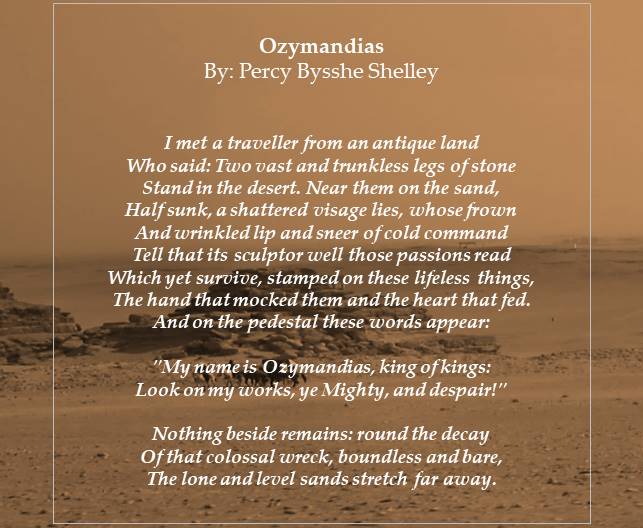
An old, mad, blind, despisd, and dying king, Princes, the dregs of their dull race. It is said to have been destroyed in an earthquake in the third century BCE. Ozymandias and England in 1819 by Percy Bysshe Shelley. Diodorus reports the inscription on the statue, which he claims was the largest in Egypt, as follows: King of Kings Ozymandias am I.


Colossal The word colossal (“vast in size, amount, extent, or scope gigantic, huge” - OED) comes from the Colossus of Rhodes, one of the Seven Wonders of the Ancient World, a huge bronze statue of the sun god near the harbor in Rhodes. Shelley and Smith remembered the Roman-era historian Diodorus Siculus, who described a statue of Ozymandias, more commonly known as Rameses II (possibly the pharaoh referred to in the Book of Exodus). In Judaism king of kings was sometimes used to refer to God in Christianity, Jesus is several times identified as “king of kings and lord of lords.” Look on my works The copy-text for this edition, the first magazine publication of Shelley's poem, has confusing punctuation: an open quotation in line 2, then another open quotation before “My name,” with a single closing quotation mark after “King of Kings.” Most editors either put the next line - “Look on my works ye Mighty, and despair!” - inside the quotations, or remove quotation marks from this section of the poem altogether. King of Kings King of kings was a title used by many rulers in the ancient Middle East. If anyone would know how great I am and where I lie, let him surpass one of my works.” When Shelley was writing the poem, the British Museum had just acquired part of a statue of Rameses. Ozymandias, the title of Shelleys one of the best-known sonnets refers to the Ancient Egyptian pharaoh, Ramesses II. Shelley does not use the traditional sonnet form, this could reflect how Ozymandias power has not survived in a traditional generational sense, the usage. The poem has a structure and style that is atypical of Shelley, and it subtly brings in the history of the rise and fall of empires. 36 Votes) Ozymandias is first and foremost a metaphor for the ephemeral nature of political power, and in that sense the poem is Shelley's most outstanding political sonnet, trading the specific rage of a poem like England in 1819 for the crushing impersonal metaphor of the statue. It describes the remnants of a statue, which is believed to be that of King Ramses II of Egypt, who was known by his Greek name Ozymandias. The actual Rameses apparently had a statue in Egypt with a similar inscription: “King of Kings am I, Osymandias. The poem ‘Ozymandias’ exemplifies Shelley’s regard for art. Ozymandias The Greek name for Rameses II of Egypt.

He disapproved of matrimony but married twice he was a vegetarian (rare at the time), a republican. Notes antique Pronounced with the accent on the first syllable. The short but tumultuous life of the poet, Percy Bysshe Shelley (1792-1822), one of the greatest of the Romantic poets of the early 19 th century, shows him to have been a man of contradictions.


 0 kommentar(er)
0 kommentar(er)
